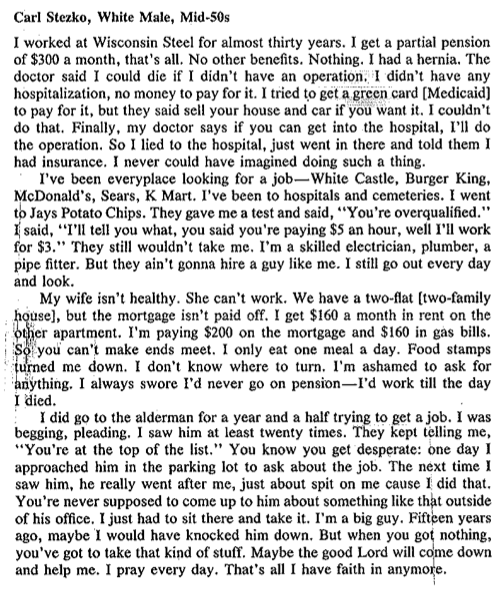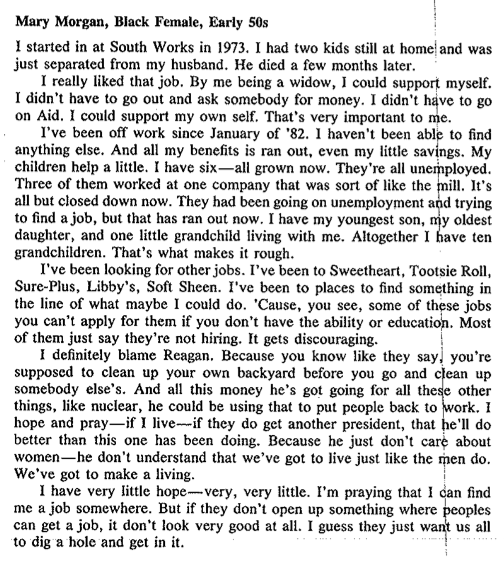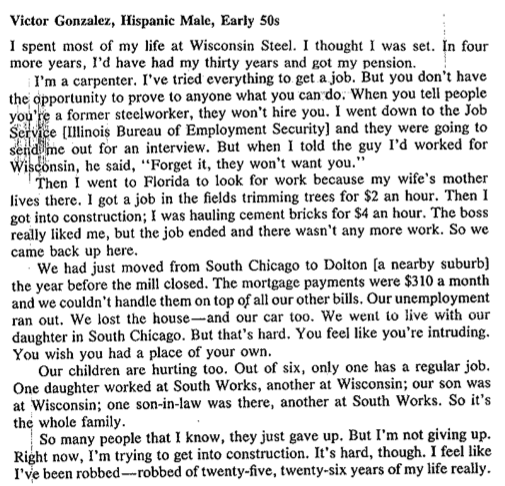Last week, we discussed the virtue of first-person narratives that speak to issues of class and economic hardship. With that in mind, please read the following three, brief narratives by laid-off steelworkers in 1984. The narratives were originally published in David Bensman and Roberta Lynch, Rusted Dreams: Hard Times in a Steel Community (1987). How do these personal testimonials enhance your understanding of the social and economic costs of deindustrialization?
Week 5 Day 2 Discussion Question 2
April 7, 2016 | 5 Comments




March 13, 2019 at 2:21 pm
Deindustrialization is interesting because of the duality of its implications. Deindustrialization occurs when an economy has developed to the point where a natural transition to a service-based economy occurs. This transition occurs because GDP has grown consistently, and the country no longer relies only on manufacturing and heavy industry. Although, the down side of this is the major portion of the work force, particularly laborers and working-class individuals, are left behind. The first narrative, written by Carl Stezko, depicts a portion of the working-class who find themselves in the middle. They are trained for specific factory jobs, but no resources have been dedicated to their retraining to adjust to life in increasingly automated industries. Thus, they are left behind as the economy and job market develops but remain over qualified for remaining “working-class” jobs. The second narrative eludes to the importance of education in a developed and deindustrialized economy. The number of jobs for uneducated individuals has shrank while jobs for educated individuals has grown. Subsequently, people with limited education are vying for much fewer job opportunities that used to support a large population. Deindustrialization clearly leaves a significant population of people behind when there are no labor force retraining initiatives. Recently, discussion of the Green New Deal and transition to a zero-emission economy in the face of climate change has brought about similar concerns. What about the coal miners? What will happen to all of the people currently employed by fossil fuel industry and its wide array of counter parts? These are questions that arise when an economy is on the brink of transition. It is not to say that we should not be concerned about the heart wrenching stories of these individuals. As Aman said, it is incredibly difficult to look past the hopelessness conveyed in these stories. However, it is not realistic, or productive, to assume an economy will remain the same in the long-term future, especially considering the current situation with climate change. That being said, it is imperative we understand the implications of deindustrialization on the personal level, as to best adapt policy to prevent this from happening once again. I believe economic transition must be accompanied with policy assure that major populations of workers are not left behind. Without this factor, the economy and people do not fully benefit from the changed system.
March 13, 2019 at 12:24 pm
The narratives from Rusted Dreams: Hard Times in a Steel Community paint a rather vulnerable picture of the social and economic impacts of deindustrialization on industrial workers. It is understandable that as the U.S. economy continued to grow and innovate that jobs would therefore become redundant and force people to seek out work or education in different fields. However, the consistent theme of hopelessness throughout the three passages is one that is hard to come to terms with. It is easy for people isolated from these people’s experiences to offer solutions ranging from re-education to unemployment benefits. But, it is difficult to capture the powerlessness many of the people experiencing this loss of jobs feel. The passages contextualize a common idea of feeling both left behind and feeling unimportant. The social and economic impacts of deindustrialization are frightening. However, the even scarier aspect of these experiences could be the psychological implications on people. Having to be told over and over again that you are not needed or necessary takes a toll on one’s ability to find self-confidence and worth. Furthermore, these people are in position where they must find it almost impossible to trust the political and economic system they are in. For many years they were promised pensions after working for a particular length of time, they were promised a steady wage and living, yet, so quickly the promises were taken away from them and they were left to fend for themselves. The three passages were interesting pieces of content that displayed an entire demographic of people that were forgotten about. To this day in the United States, this issue continues to be at the forefront of voting issues. As such, it is easy to understand how certain occurrences, one being Donald Trump becoming president, were able to occur. The economic and social impacts are generational and continue to exist to this day. Still people working in industrial and manufacturing sectors have a distrust of the system as the system appears not to care for them. It is seems hard to imagine a scenario playing out in which people in these industries will not have to deal with the psychological harm of being told they are no longer useful. Personally, I believe it will be an extremely prevalent issue that continues into the future as the innovation occurring around the world continues to prosper.
March 12, 2019 at 9:35 pm
The above narratives taken from Rusted Dreams: Hard Times in a Steel Community, about three laid off steel workers and their struggles with unemployment, enhance my understanding of the dependence the working class has of domestic, blue collar jobs. Though written in 1984, when deindustrialization was becoming a theme in the United States, these narratives still reign true in the present day. In the past decade, manufacturing and industrial jobs have once again began to fade. Many have been lost to the rapid technological advances, and many others have been lost to corporations outsourcing their work to other countries to find cheaper labor. Many industrial workers in the 1980’s blamed President Reagan for allowing the outsources. Learning from one mans mistakes, I think President Trump has put an emphasis on doing everything in his power to negotiate with corporations to bring their industrial plants back into the United States. Still though, the amount of jobs technology has taken and will continue to take is a serious problem for the working class in America. Reading personal narratives like these put in to perspective the lifestyle America’s working class must live. All three of the accounts relay families who live paycheck to paycheck, and are fully dependent on their job to support their families. It is sad to read the struggles these people undergo when industrial jobs get cut.
March 12, 2019 at 7:18 pm
The narratives taken from Rusted Dreams: Hard Times in a Steel Community, of 1984 steelworkers and their struggles with unemployment, further elucidate the social and economic costs of deindustrialization. As the country transitioned away from manufactured products and more toward service spending, the importance of employment within manufacturing heavily dropped. Thus, with more technology and less need for work in this area, many workers lost their jobs and suffered tremendously as a result. Lacking any benefits and having only small pensions, Carl Stezko, Mary Morgan, and Victor Gonzalez – all of different races/ethnicities – reveal in their narratives deindustrialization-imposed suffering. Without proper benefits, for example, Stezko had to lie about possessing insurance in order to retrieve a life-saving operation, revealing the utterly unsympathetic nature of the social system after deindustrialization. Morgan, an unemployed widow with many dependents reveals the patriarchal disregard of working women during this time period and economic preoccupation with less “immediate” domestic affairs. And, all three of them unveil the strong cost of occupational immobility that results either from lack of proper skills for service jobs or simply from geographically-imposed restrictions. In this way, unemployment becomes structural, being secured by social, economic, and political obstacles resulting from deindustrialization – further exposing the ills of the American Dream.
March 12, 2019 at 7:05 pm
Deindustrialization has been a large result of globalization, outsourcing, and automation and technology advancements in America. These are all proclaimed to be a good thing for the country as well as increasing net benefit. Prices go down, choice and convenience, as well as innovation all go up. Sometimes politicians even say that jobs increase. However, research shows that job increases can concentrate in very particular sectors and income brackets, so figures can be misleading. While we know there can be large job losses over time in these types of sectors, personal narratives can be an incredibly powerful way to remind everyone what is at stake and the other side of many of these issues.
Carl Stezko talks about losing his job in steel manufacturing and we can assume from the piece he has been laid off. Carl’s story certainly points to the unfortunate distress that many of these formerly successful families are suddenly put under, to no fault of their own. Carl was living the American Dream, was accomplished, educated, and had job prospects. However, with international trade and often with innovation, there will be winners and losers. Unfortunately Carl was designated as one of the losers. Carl’s story reminds us of the eventual social causes of a certain proportion of the population suddenly being dropped into poverty with little warning. If he were to go on food-stamps, become homeless, or have unfinanced or unplanned medical complications, this would represent a considerable marginal cost to society. Narratives like this can remind people of the struggles people in these specific positions go through.
Mary Morgan explains some of the frustration that Carl mentions as well. It seems like these people have nowhere left to turn. She tragically explains that there is no other refuge for people than to dig a hole and get in it. Debating about unemployment vs. visualizing feelings like this one are two different things, and this clearly has a strong effect when we look at just one person. Morgan explains political frustrations that the President is allocating funds to other issues before securing the welfare of more Americans. Again, the personal narrative reminds us the frustration and tragedy associated with many common political decisions, which we do not usually fully consider.
Victor Gonzalez’s story tells a similar story. I personally don’t quite understand the stigma against the steelworkers in this particular instance, but the desperation and frustration is the same. The description of his family getting into the same business as he did, as well as his friends, can offer an idea of the nature of this problem when jobs leave certain areas. The effects are often not evenly spread out or distributed among geographic, income, or race groups. Victor’s situation offers an anecdotal representation of that, which is, in the case of these three stories, just as strong if not stronger than a numerical representation.